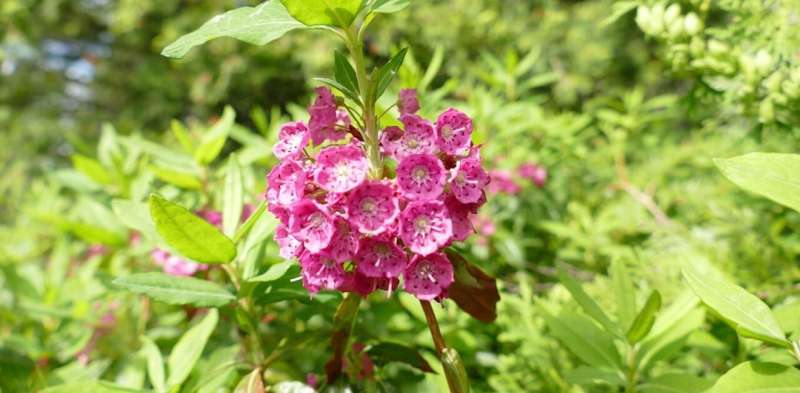This article has been reviewed according to Science X's editorial process and policies. Editors have highlighted the following attributes while ensuring the content's credibility:
fact-checked
trusted source
written by researcher(s)
proofread
Making the most out of boreal plant resources

Plants produce molecules to interact with their environment and protect themselves against external threats. These molecules can also have antioxidant, anti-inflammatory and antibacterial properties, some of which are beneficial to human health. These properties are valued by traditional medicines and inspire the development of medicinal products by contemporary chemists.
The majority of medications on the market are or are derived from natural products. Among others, several classes of antibiotics used to combat bacterial infections are based on the chemical structure of natural products.
For example, erythromycin A is a natural antibiotic produced by a micro-organism. It is used to combat various bacterial infections. Another antibiotic, clarithromycin, is made by changing the structure of erythromycin A.
Derived from living organisms, biobased products also have applications in a wide range of fields, including cosmetics, food supplements, crop protection products and animal feed.
Our research group at the LASEVE laboratory at the Université du Québec à Chicoutimi is interested in the use of natural products derived from elements in the boreal forest. The choice of species studied is based in part on the traditional uses of plants by Indigenous communities.
Discovering fascinating molecules
Molecules of interest are often extracted by macerating plants in various solvents (water, ethanol, glycerine). Biological tests are used to quickly assess the benefits of the extracts. An example would be to measure the antibiotic power of natural products by treating bacteria grown in the laboratory.
Biological tests also make it easier to select and isolate the molecules with the most interesting properties; this is known as "bioguided fractionation."
Balsam poplar as an antibacterial agent
Methicillin-resistant Staphylococcus Aureus (MRSA) is one of the six bacteria causing the majority of antibiotic resistance-related deaths worldwide. Bacterial resistance to antibiotics compromises our ability to fight bacterial infections. In this context, the discovery of new classes of antibacterial agents is becoming a public health issue.
More specifically, we identified a family of antibacterial molecules extracted from balsam poplar (Populus balsamifera) buds. These original compounds, known as balsacones, are active against MRSA. What's more, unlike other antibiotics, their use does not appear to induce resistance in the bacteria treated.
However, the yields from isolating balsacones from balsam poplar buds are low. In other words, for one kilogram of plant, we only manage to obtain around ten milligrams of molecules—quantities that are far too small to study the properties of these molecules in detail.
Nevertheless, balsacones remain promising products in the fight against bacterial resistance.
A greener production
Molecules of interest are usually obtained by synthesis. In other words, they are derived from the successive assembly of different 'building blocks' to produce the desired molecule. Conventional approaches use simple building blocks from the petroleum industry. These methods are tedious and require several stages of synthesis, all of which are based on the use of harmful and non-renewable raw materials.
The coming scarcity of fossil fuels, combined with the environmental issues surrounding petrochemicals, call for the development of more sustainable alternatives. One strategy for overcoming these limitations is to use natural products as 'building blocks' for the synthesis of high value-added molecules. These building blocks are an ideal replacement for petroleum-based products.
This approach, known as xylochemistry when the 'building blocks' come from wood, avoids the use of non-renewable raw materials. The idea behind this method is to simplify the synthesis sequence by using biosourced molecules. What's more, the variety of natural precursors available means that the products available can be diversified and new derivatives discovered.
Based on this principle, we have synthesized several balsacones in a single synthesis step, by combining two biosourced molecules.
The procedure is based on several principles of so-called "green chemistry." It has also made it possible to produce novel molecules related to balsacones in order to gain a better understanding of the structural parameters that give balsacones their antibacterial properties.
Valuing the treasures of the boreal forest
Every year, the Québec forest industry produces more than 1.7 million tons of bark.
Little use is made of these residues, despite their high content of molecules with interesting properties.
Our laboratory is working to develop methods to add value to these by-products of forestry by identifying the molecules they contain and characterizing their biological properties.
We are also interested in other plant species that originate in the boreal forest and are indirectly involved in its management. For example, narrow-leaved kalmia (Kalmia angustifolia) is an invasive plant typical of boreal ecosystems. Its proliferation can hinder the reforestation of areas subject to disturbances such as insect pest epidemics or fires, the frequency and severity of which are likely to increase in the current context of climate change.
Our team's research has shown that this species contains a molecule that can be used to produce balsacone A, a compound with antibacterial properties.
By harvesting narrow-leaved kalmia, our approaches to extracting and processing biomolecules could increase the added value of this biomass, as part of a circular economy approach.
For example, plant extracts from the boreal forest can lead to the discovery of new substances that can help address global public health issues.
Using natural molecules as building blocks to prepare more complex derivatives also makes it possible to generate high added-value products in a more environmentally-friendly way.
In this context, the study of natural products will make a major contribution to sustainable development and forest productivity.
Provided by The Conversation
This article is republished from The Conversation under a Creative Commons license. Read the original article.![]()





















